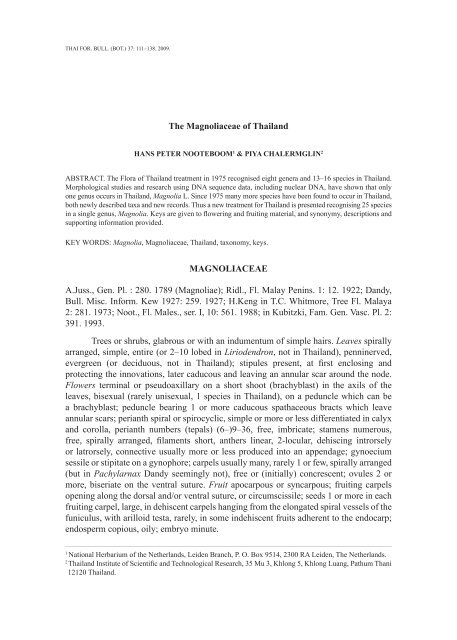You also want an ePaper? Increase the reach of your titles
YUMPU automatically turns print PDFs into web optimized ePapers that Google loves.
<strong>THAI</strong> FOR. BULL. (BOT.) 37: 111–138. 2009.<br />
The Magnoliaceae of Thailand<br />
Hans PeTer nOOTeBOOM 1 & Piya CHaLerMGLin 2<br />
ABSTRACT. The Flora of Thailand treatment in 1975 recognised eight genera and 13–16 species in Thailand.<br />
Morphological studies and research using DNA sequence data, including nuclear DNA, have shown that only<br />
one genus occurs in Thailand, Magnolia L. Since 1975 many more species have been found to occur in Thailand,<br />
both newly described taxa and new records. Thus a new treatment for Thailand is presented recognising 25 species<br />
in a single genus, Magnolia. Keys are given to flowering and fruiting material, and synonymy, descriptions and<br />
supporting information provided.<br />
KEY WORDS: Magnolia, Magnoliaceae, Thailand, taxonomy, keys.<br />
MaGnOLiaCeae<br />
A.Juss., Gen. Pl. : 280. 1789 (Magnoliae); Ridl., Fl. Malay Penins. 1: 12. 1922; Dandy,<br />
Bull. Misc. Inform. Kew 1927: 259. 1927; H.Keng in T.C. Whitmore, Tree Fl. Malaya<br />
2: 281. 1973; Noot., Fl. Males., ser. I, 10: 561. 1988; in Kubitzki, Fam. Gen. Vasc. Pl. 2:<br />
391. 1993.<br />
Trees or shrubs, glabrous or with an indumentum of simple hairs. Leaves spirally<br />
arranged, simple, entire (or 2–10 lobed in Liriodendron, not in Thailand), penninerved,<br />
evergreen (or deciduous, not in Thailand); stipules present, at first enclosing and<br />
protecting the innovations, later caducous and leaving an annular scar around the node.<br />
Flowers terminal or pseudoaxillary on a short shoot (brachyblast) in the axils of the<br />
leaves, bisexual (rarely unisexual, 1 species in Thailand), on a peduncle which can be<br />
a brachyblast; peduncle bearing 1 or more caducous spathaceous bracts which leave<br />
annular scars; perianth spiral or spirocyclic, simple or more or less differentiated in calyx<br />
and corolla, perianth numbers (tepals) (6–)9–36, free, imbricate; stamens numerous,<br />
free, spirally arranged, filaments short, anthers linear, 2-locular, dehiscing introrsely<br />
or latrorsely, connective usually more or less produced into an appendage; gynoecium<br />
sessile or stipitate on a gynophore; carpels usually many, rarely 1 or few, spirally arranged<br />
(but in Pachylarnax Dandy seemingly not), free or (initially) concrescent; ovules 2 or<br />
more, biseriate on the ventral suture. Fruit apocarpous or syncarpous; fruiting carpels<br />
opening along the dorsal and/or ventral suture, or circumscissile; seeds 1 or more in each<br />
fruiting carpel, large, in dehiscent carpels hanging from the elongated spiral vessels of the<br />
funiculus, with arilloid testa, rarely, in some indehiscent fruits adherent to the endocarp;<br />
endosperm copious, oily; embryo minute.<br />
________________________________________________________________________________________________________________________________________________________<br />
1 National Herbarium of the Netherlands, Leiden Branch, P. O. Box 9514, 2300 RA Leiden, The Netherlands.<br />
2 Thailand Institute of Scientific and Technological Research, 35 Mu 3, Khlong 5, Khlong Luang, Pathum Thani<br />
12120 Thailand.
















